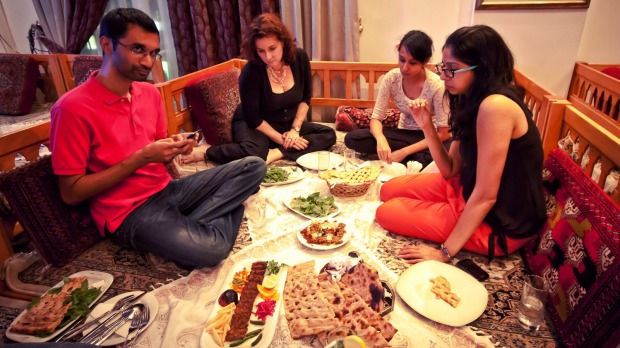
"The prophet Muhammad taught us that a person should eat using just three fingers," says Arva Ahmed, passing a plate of char-grilled meat and yoghurt to a group of diners sitting cross-legged on the carpeted floor. Then she breaks into a smile. "But that was before we knew about rice. If a person eats with three fingers now, I think they would be on a diet."
The diners all laugh, relieved they won't have to tackle the meat, not to mention the bowls of spiced basmati rice served alongside them, with just three digits. We might be eating with our hands for this meal, but at least we'll be eating with our whole hands.
A few people tuck in straight away, tearing off bits of meat, rolling rice into balls before stuffing the portions in their mouths.
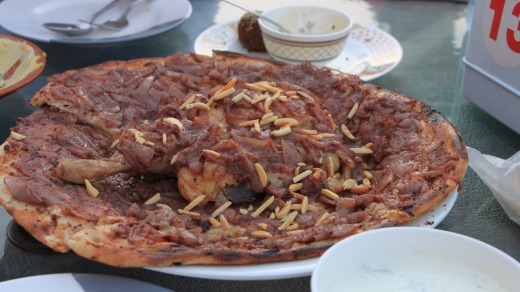
This is traditional Middle Eastern eating, but it's not just the method that's interesting here at Al Tawasol restaurant in Dubai. It's the fact that the food we're eating is Emirati. It has elements of Yemeni cuisine, and influences from Oman, but mostly this is the food of the United Arab Emirates, something amazingly hard to find on its home soil.
Dubai has much to offer diners, but its culinary scene usually comes in the form of grand Michelin-starred eateries, or sprawling brunch buffets and poolside canapes with cocktails on the side. What visitors often miss is the traditional food of the Middle East, whether that's from the UAE or from gastronomically obsessed neighbours such as Iran, Syria, Palestine or Egypt.
That's why I and so many others have joined Frying Pan Adventures, a food tour of the "real Dubai", an experience of eats on the streets of Deira. This area, close to the airport, is the closest Dubai has to an old town, and it's a world away from the glitz of the tourist resorts and mega-developments familiar to most visitors.
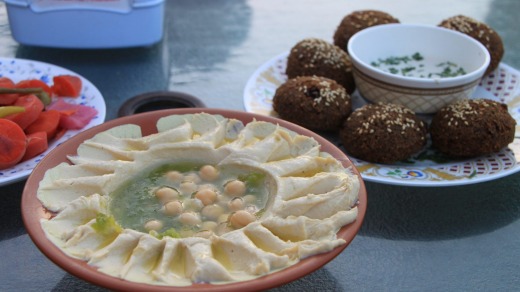
Deira has character. Its bustling streets are lined with shops and restaurants serving affordable, traditional food from around the Middle East. The trick is to know where to go and what to order, which is where Arva comes in. She's been blogging about Dubai's "hole-in-the-wall" ethnic food scene for five years, and knows the restaurants around Deira as well as anyone. Think Middle Eastern food is just baklava and kebabs? You haven't even scratched the surface.
Let's go back to the beginning of today's tour, and a meeting where all of the best food can be found: on the streets. Gathering on Al Muraqqabat Road, we're surrounded not just by restaurants and street stalls, but by people from a melange of Middle-Eastern ethnicities: Arabs and Persians who have come to find their fortune in this oil and development-rich state. We're each given earpieces to make it easier to hear Arva over the din, and then head to our first foodie destination, Sultan Dubai Falafel.
Where did falafel originate? Wars have been started over smaller questions. It might be Egyptian, it might be Lebanese, it might be Israeli or it might be Palestinian. In Dubai, however, Arva says, "there are no wars – just food".
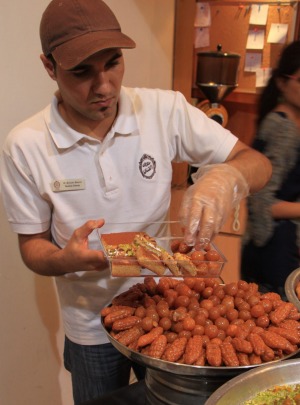
The Sultan Dubai serves the Palestinian version of falafel, and we crowd into the small restaurant to watch the cook at work, scooping up lumps of minced chick peas, herbs and spices and dumping them in a deep-fryer. The result is incredibly tasty.
I'm about to ask for a second helping when Arva introduces her "percentage system". The idea is that with so many restaurants to visit this evening, our stomachs should only be full to a certain percentage at any given point in time. After this falafel we should be five per cent full. Hmm. I better slow down.
Next up is another Palestinian restaurant, Qwaider al Nabulsi, a cheaper establishment with plastic tables and chairs spilling out onto the street. No Michelin stars for this place – it's the food of the people, and one that seems to be embraced by all manner of Dubai residents.
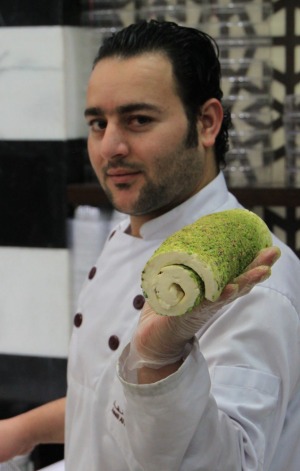
Our group manages to grab a table and soon we're feasting on Middle Eastern food I've never even heard of: there's musakhan, a dish of flat bread baked with roasted chicken, onions, olive oil, almonds, pine nuts and sumac, served with yoghurt; and kunafa, a sweet cheesecake topped with thin noodles, crushed nuts and sugar syrup. It's all delicious.
"Did you know," Arva says between mouthfuls, "that there are more cookbooks printed in Arabic than any other language? People from the Middle East are obsessed with food. Obsessed."
And Dubai, this chef's stockpot of cultures and beliefs, serves as a natural meeting point for all of these cuisines. This is, remember, a city-state made up of only 10 per cent native Emiratis. The rest of the population are expats from India, Pakistan, Bangladesh and Somalia, as well as Western countries and the neighbouring Middle Eastern states. "We're looking at this region through the lens of flavour," Arva says.
And it looks delicious. Next up we're heading a few doors down to Al Samadi, a well-known sweet shop that specialises in baklava, another much-loved Middle Eastern foodstuff with a disputed origin.
The glass counters in Al Samadi are lined with Lebanese-style pastries, layers and layers of sweet dough stuffed with nut fillings and honey. It's clear that the bakers here take their product very seriously as they walk us through each variant of the sweet.
"I have a secret for shops like these," Arva says, dropping her voice to a conspiratorial level. "You have to make hungry eyes at the food. If you look hungry enough, and interested enough, the bakers will always let you try some."
I do my best at Al Samadi, staring longingly at the rows and rows of baklava, and it isn't long before I've got a piece of sweet pastry in my hands. Maybe it was just to prevent me slobbering on the counter, but still, this is success.
With stomachs that are supposed to be about 20 per cent full but are really about 50 per cent after all of the hungry-eyed tastings at Al Samadi, we make our way a few blocks down towards Dubai Creek to Al Rigga Road, another hotspot for cheap, authentic Middle Eastern food. First port of call is Damascus Sweets, a Syrian shop that specialises in ice-cream. Apparently, we're having pre-dinner dessert.
Just watching the preparation of Syrian ice-cream, or booza, is an experience, as the chef pounds his creation with a huge wooden pestle, giving the ice-cream a stringy consistency, before flattening it out, adding pistachios, rolling it into a large log and slicing off snail-shaped discs to hand around. Once again, delicious, and I'm starting to feel like it's time to give up on this whole percentage thing.
We call into Soarikh, an Egyptian takeaway joint that does "feteer meshaltet", a sort of Egyptian pizza, which, judging by the speed at which it's disappearing out of the door in cardboard boxes, is insanely popular around here. It's also very tasty, and not much like Western pizza at all.
Al Tawasol is next, where we sit cross-legged on the floor, replicating the experience of the desert dwellers of the old Emirates, and tuck into "mandi", a chicken-and-rice dish that actually originated in Yemen, though it's been enthusiastically embraced around these parts. We dig in with our hands, getting all authentic as we tear off bits of buttery chicken meat, add some spiced rice and yoghurt, and try to get as much into our mouths as possible.
There's charcoal-grilled lamb as well, plus salads, raisins and nuts. My percentage must be at about 110 by now, and we've still got one final stop: Sadaf, an Iranian restaurant on nearby Al Makhtoum Road. There, accompanied by the strains of a live Persian band, we'll eat char-grilled shish kebabs, perfectly fluffy basmati rice, and traditional Iranian flatbread.
My stomach will burst the shackles of my belt at 120 per cent full as we stuff the last morsels of delicious food in our mouths, and Arva finally bids us farewell. I wobble off into the night, aching but satiated, convinced that for the next few days at least I will have to take the advice of the prophet and eat with three fingers. Or four at the most.
definitelydubai.com
Emirates Airline flies twice daily from Sydney and Melbourne to Dubai. See emirates.com/au.
Frying Pan Adventures runs five-hour "Middle Eastern Food Pilgrimage" tours of Deira, which include food, some drinks and transfers from the Mall of the Emirates, for AED415. See fryingpanadventures.com.
FIVE FANCY RESTAURANTS IN DUBAI
Spoil yourself with these upper-class eateries
PIERCHIC
Trying to impress someone? Then book dinner at Pierchic, a restaurant on the end of a – you guessed it – pier, with stunning views of the Dubai skyline. The menu is a seafood extravaganza, and the prices ensure a certain sense of exclusivity. See jumeirah.com.
TRAITEUR
This might just be the mother of all Dubai brunch buffets, a huge space in which diners can walk through the open kitchen to pick up their food: tasty morsels such as barbecued lobster, freshly shucked oysters and foie gras pate. See restaurants.dubai.hyatt.com.
QBARA
This sprawling fine-diner is set over two levels, one a mezzanine overlooking the action below, and features some of the best food in Dubai, with a modern fusion of Middle Eastern flavours. See qbara.ae.
ZENGO
One of the most popular restaurants in Dubai, Zengo is a beautiful open-air space at Le Royal Meridien Hotel, offering a menu of fresh Japanese and Mediterranean dishes to go with the stunning views. See zengo-dubai.com.
ARMANI/AMAL
One of a whole suite of Armani eateries in the hotel below the Burj Khalifa, Amal showcases Indian-style fine-dining, with curries and other traditional foods prepared at the table in front of you. See dubai.armanihotels.com.